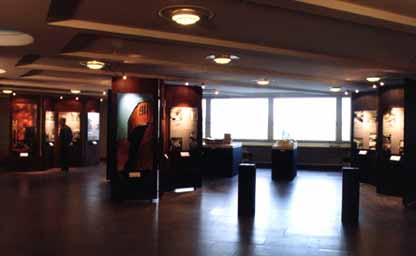6/2/2001
Alvar Aalto
Bellas Artes, Mexico City
And red brick: space, form, surface. The exhibition is about how Aalto used brick, creating space, form and surface with it. "When used the right way," said Aalto, "brick is worth its weight in gold." And if brick refused to bend to Aalto's purposes, such as curved shapes, he simply designed a new type of brick. Exhibition organized by The Alvar Aalto Museum.

And red brick: space, form, surface.
Exhibition organized by The Alvar Aalto Museum.
Alvar Aalto's architecture comprises a number of different facets. The products of his early
years in the 1920s were part of Nordic classicism, followed by a short but intense period of
white functionalism at the end of that decade and beginning of the next. Aalto established his
international fame in the mid-30s, when the Paimio sanatorium, perhaps his most famous
building, was completed. The basic approaches for his design output also date from this
period.
Alvar Aalto's characteristic style, which involves concepts such as free form, organic shapes,
practical and humane aspects, a connection between nature and architecture and natural
materials was crystallized in his red brick period, from the end of the 1940s to the mid-50s.
The historical depth of Aalto's architecture is also evident in buildings from this period: motifs
and themes from classical antiquity and from the Medieval townscapes of the Mediterranean.
The exhibition Alvar Aalto and red brick: space, form, surface is about how Aalto used brick,
creating space, form and surface with it. "When used the right way," said Aalto, "brick is worth
its weight in gold." And if brick refused to bend to Aalto's purposes, such as curved shapes, he
simply designed a new type of brick.
The exhibition lends particular emphasis to Aalto's famous Säynätsalo Town Hall (1949-52) and
his Experimental House in Muuratsalo (1952-54), which are presented in model form as well as
pictures. Both these buildings are in Jyväskylä, Aalto's home town. The Experimental House in
Muuratsalo was the summer home of the Aalto family. The exhibition also provides a brief
overview of other buildings of note such as the Sunila pulp mill, the University of Jyväskylä,
Helsinki University of Technology, the Social Insurance Institution and the House of Culture,
highlighting the exhibition's three themes: form, surface and space.
The exhibition features scale models, sectional models, drawings and colour and black and
white photographs. There are 16 exhibition panels, which are 1000x2400 mm in size and about
50 mm thick. They can be displayed as free-standing units or against a wall. The structure of
the panels includes integrated halogen lighting and transformers. The size of the scale models
is 1200x1200 mm and 1200x600 mm, height with stands about 1200 mm. The exhibition
further includes 6 bricks with special pedestals. Photographs are from the archives of the Alvar
Aalto Museum and the Alvar Aalto foundation, while the drawings are from the archives of the
foundation. There are also some photographs from the archives of the Finnish Brick Industry
Association. The design of the exhibition brings out the feel of brick and natural materials
through the colours and materials used and the general ambience. The exhibition is arranged
by the Alvar Aalto Museum, and has been designed by the architects, Davidsson Oy.
Bellas Artes, Mexico City, Mexico
For more information: Hanni Sippo - TEL +358 (0)9 480 123 - GSM +358 (0)40 581 5821
e-mail: hanni.sippo@netlife.fi



